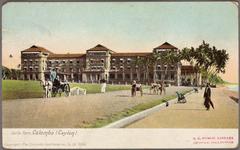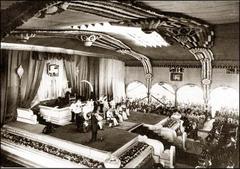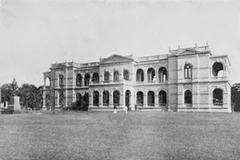
Old Colombo Dutch Hospital: Visiting Hours, Tickets, and Complete Guide to Colombo’s Historical Landmark
Date: 04/07/2025
Introduction
The Old Colombo Dutch Hospital stands as a testament to Colombo’s colonial legacy, seamlessly blending centuries-old heritage with the city’s contemporary vibrancy. Originally established in the 17th century by the Dutch East India Company, this architectural gem is now a thriving lifestyle precinct, offering visitors a unique journey through history, culture, and modern leisure. Conveniently situated in the heart of Colombo’s Fort district, the Old Dutch Hospital invites both locals and travelers to experience its rich past, distinctive architecture, curated shopping, world-class dining, and dynamic cultural events—all within walking distance of other key Colombo historical sites (Serendib Trail, Asia Tripstay, Cambridge University Press).
Table of Contents
- Introduction
- Historical Overview
- Architectural Features
- Restoration and Adaptive Reuse
- Visitor Information: Hours, Tickets, Accessibility
- Shopping and Dining
- Cultural Events and Experiences
- Getting There and Travel Tips
- Nearby Attractions
- Frequently Asked Questions (FAQ)
- Sustainability and Responsible Tourism
- Conclusion
- References
Historical Overview
Origins and Colonial Era
Established in the mid-1600s, the Old Colombo Dutch Hospital is one of Sri Lanka’s oldest surviving colonial-era buildings. Built by the Dutch after they captured Colombo from the Portuguese in 1656, its primary purpose was to serve as a hospital for Dutch East India Company staff, sailors, and colonial officials. Its strategic location within the Colombo Fort allowed efficient access to medical care for those arriving by sea, and the building was originally bordered by a canal, which enabled transportation of patients and supplies directly from the port (Cambridge University Press).
Evolution Through Time
Following the British takeover in 1796, the hospital’s role shifted. Over the years, it served various administrative purposes, including as an apothecary and police station. Despite these changes, the structure’s core features survived, thanks to robust Dutch construction. After Sri Lanka’s independence, the building fell into disrepair, until a major restoration project in the early 21st century transformed it into the Dutch Hospital Shopping Precinct, reinvigorating Colombo’s Fort district (Serendib Trail, Asia Tripstay).
Architectural Features
Layout and Design
Occupying nearly half a hectare, the complex consists of five wings surrounding two open courtyards, maximizing natural light and ventilation. The central courtyard, once dedicated to patient recovery, is now a social and cultural hub. Thick brick and coral stone walls—often more than 50 centimeters wide—along with high ceilings, massive teak beams, and wide verandas, are key elements of the Dutch colonial architectural style. This design ensures insulation from Colombo’s tropical heat and monsoon rains, while the open verandas and large windows enhance cross-ventilation (Cambridge University Press).
Adaptive Details
The building’s courtyards, originally sparsely planted, are now adorned with lush greenery, offering tranquility amidst the city bustle. Though the original canal has been filled in, its legacy lives on in nearby “Canal Row.” The hospital’s spatial organization and materials showcase a blend of European design and local adaptation, influencing later public architecture across Sri Lanka (Asia Tripstay).
Restoration and Adaptive Reuse
By the early 2000s, the Old Dutch Hospital was in a state of neglect. Recognizing its historical and architectural importance, the Sri Lankan government undertook a meticulous restoration beginning in 2011. The project followed principles of adaptive reuse, prioritizing the preservation of original features such as terracotta roof tiles, wooden beams, and brickwork, while introducing modern amenities in a reversible and sustainable manner. The result is a precinct that celebrates its colonial heritage while serving as a vibrant commercial and cultural center (Serendib Trail, Asia Tripstay).
Visitor Information: Hours, Tickets, Accessibility
- Opening Hours: Daily from 10:00 AM to 10:00 PM. Some restaurants and bars may stay open later.
- Entry Fee: No ticket or entry fee is required. Visitors are free to explore the precinct; charges apply only for purchases or dining.
- Guided Tours: Occasionally available via third-party operators or during special events. Check with official tourism websites or at the precinct’s info desk for details.
- Accessibility: The ground floor is wheelchair accessible, with ramps and wide pathways. Upper floors are accessed by stairs and may not be fully accessible for those with mobility challenges.
- Facilities: Modern restrooms, free Wi-Fi in most venues, security, and seating areas are provided. ATMs and currency exchange are nearby.
Shopping and Dining
Shopping
The Dutch Hospital precinct features a curated selection of boutiques that highlight Sri Lankan craftsmanship and international brands:
- Barefoot: Renowned for handwoven textiles and unique gifts.
- Spa Ceylon: Offers luxury Ayurveda products and treatments.
- Odel Luv SL: A flagship for Sri Lankan souvenirs and lifestyle items.
- Luv SL: Contemporary Sri Lankan-themed merchandise.
You’ll also find jewelry stores, art galleries, designer sunglasses outlets, and Ceylon tea shops—making the precinct an ideal destination for high-quality, authentic shopping.
Dining
Regarded as one of Colombo’s top culinary destinations, the precinct’s restaurants and cafes cater to diverse tastes:
- Ministry of Crab: Internationally acclaimed for fresh lagoon crab and seafood.
- Colombo Fort Café: Mediterranean and fusion cuisine with an open-air setting.
- The Dutch Pub: Lively spot for local and international drinks.
- Heladiv Tea Club: A nod to Sri Lanka’s tea heritage, perfect for afternoon tea.
Many venues offer outdoor seating in the courtyards, live music, and themed events, especially during weekends and festivals.
Cultural Events and Experiences
The Old Dutch Hospital regularly hosts:
- Art Exhibitions: Showcasing Sri Lankan and international contemporary artists.
- Live Music: Jazz, fusion, and traditional Sri Lankan performances.
- Festivals and Markets: Seasonal events, food festivals, and holiday celebrations.
For up-to-date event listings, check official precinct or venue social media pages.
Getting There and Travel Tips
- Location: Hospital Street, Colombo Fort (Colombo 01), opposite the World Trade Center.
- Transport: Easily accessible via taxi, tuk-tuk, or on foot from Colombo Fort Railway Station. Multiple bus routes serve the area.
- Parking: Limited street parking; public transport or taxis are recommended.
- Best Time to Visit: Evenings are especially atmospheric, with illuminated courtyards and live entertainment. The dry season (November–April) offers the most comfortable weather.
Travel Tip: Reserve tables in advance at popular restaurants, especially on weekends or during festivals.
Nearby Attractions
Maximize your visit by exploring other Colombo historical sites within walking distance:
- Colombo Lighthouse: Panoramic views of the harbor and ocean.
- Galle Face Green: Seaside promenade popular for sunsets and street food.
- Pettah Market: Bustling bazaar for local produce and textiles.
- Wolvendaal Church: Another fine example of Dutch colonial architecture.
Frequently Asked Questions (FAQ)
Q: Is there an entry fee?
A: No, entry to the precinct is free.
Q: What are the visiting hours?
A: Open daily from 10:00 AM to 10:00 PM.
Q: Is the site wheelchair accessible?
A: Yes, the ground floor and main pathways are accessible; upper floors may not be.
Q: Are guided tours available?
A: Yes, but primarily via third-party operators or during special events.
Q: Can I take photos?
A: Generally yes, but please ask before photographing inside shops or during private events.
Sustainability and Responsible Tourism
The Dutch Hospital precinct and its tenants actively promote sustainable practices, including waste reduction and eco-friendly products. Visitors are encouraged to support local artisans, use reusable bags, and dispose of waste responsibly.
Conclusion
The Old Colombo Dutch Hospital is a living monument to Sri Lanka’s colonial history and its vibrant present. Its transformation from a 17th-century hospital to a bustling lifestyle precinct is a model of adaptive reuse and sustainable conservation. Whether you’re drawn by its architectural beauty, cultural programming, shopping, or renowned dining, the precinct offers something for every visitor.
Plan your visit during the drier months, check official resources for event updates and visiting hours, and reserve your dining spots in advance. Immerse yourself in Colombo’s rich heritage and dynamic urban culture at this iconic site.
For guided tours, event schedules, and exclusive offers, download the Audiala app and follow our social media channels. Explore more about Colombo’s history and attractions in our related articles.
References
- Visiting the Old Colombo Dutch Hospital: History, Restoration, and Visitor Information, 2025, Serendib Trail (https://www.serendibtrail.com/dutch-hospital/)
- Visiting the Old Colombo Dutch Hospital: History, Architecture, and Practical Information, 2025, Asia Tripstay (https://asia.tripstay.net/the-colonial-echoes-of-the-old-dutch-hospital-colombo/)
- The Seventeenth Century Dutch Hospital in Colombo, 1999, Cambridge University Press (https://www.cambridge.org/core/services/aop-cambridge-core/content/view/40172044BB1EFEB201932DA808E5ABB7/S0025727300043994a.pdf/the-seventeenth-century-dutch-hospital-in-colombo.pdf)
- Old Colombo Dutch Hospital Visiting Hours, Tickets & Guide to Colombo Historical Site, 2025, Colombo City Org (https://www.colombocity.org/old-dutch-hospital/)
- Sri Lanka Tourism Development Authority Official Website, 2025 (https://www.srilanka.travel)






